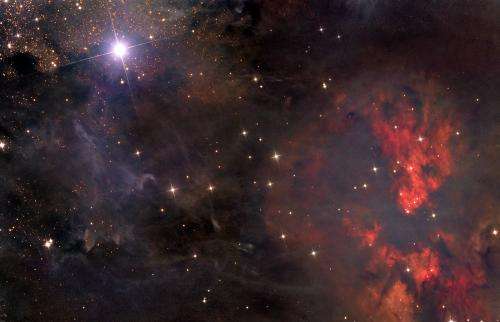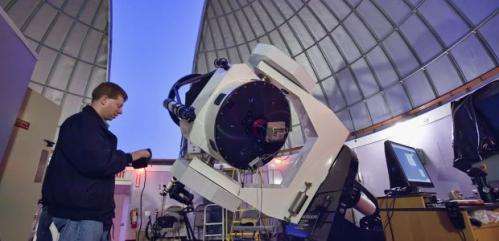'Heaven and hell' in the serpent's tail

Renowned University of Arizona astrophotographer and astronomy educator Adam Block has taken this photograph of glowing, colorful beauty shimmering behind a dark cloud of dust and gas in the constellation Serpens.
"Stars to the upper left and a smoldering red ember glow to the bottom right give this vista an eerie feeling with its odd coloration. Although taken under less than ideal conditions this past summer, I finally had an opportunity to complete this two-frame mosaic," Block said about his image, adding that he felt the two contrasting regions reminded him in a way of the figurative duality of heaven and hell.
The photograph brings us a glimpse of what one would see while traveling deep into the interstellar space, along the plane of the galaxy. The red glowing cloud, officially designated as SH2-64, is what astronomers call an emission nebula, a vast cloud of gas and dust permeating the cosmic canvas, lit up by the radiation of nearby, hot stars.
"You can see that in the red area, toward the lower right of the image," Block explained. "In the glowing, red area toward the lower right of the image, that's where star formation is occurring. The young stars embedded in the cloud make the area glow."
"Since the cloud is not completely opaque, you see can see further out into the galaxy toward the upper left, where the clouds break up a little bit," Block said.

The bright star in the upper left of is the object that is probably closest to us, he explained, adding that this star is still far enough from Earth that it would not be possible to see it even on the clearest of nights. The clouds are far behind that star, and behind the clouds are more stars, even further away. SH2-64, the star-forming region, is about 1,000 to 2,000 light-years away.
"I saw this object on a wide-field image taken by another amateur astronomer, and I thought if I look at it at a more magnified scale with a more powerful telescope, it might be interesting," Block said. "I really enjoyed the intricate nature of the interwoven gas and dust, but it's too dim of an object and it's not emitting a whole lot of light. You see it more by what it blocks, not by what you see."
The image of this region of Serpens, which means snake, was taken with the Schulman Telescope at the UA's Mt. Lemmon SkyCenter. It is the largest telescope in the country used exclusively for education and public outreach and, in addition to its local functions, has been custom-designed for worldwide public access for astrophotography via the Internet.
Block, who grew up fascinated with astronomy and all things in the sky, said in an earlier interview that the main motivation behind his photography is sharing what he sees with others.
"Growing up, I would set up my telescope in our driveway and see all these wonderful things, but I wanted to turn around and show someone else," Block said. "I wanted to say, 'Hey, check this out. This is really fascinating. This is awesome.' I didn't really have that opportunity, and I wanted to do that."
A recipient of the 2012 Advanced Imaging Hubble Award, Block joined the UA Steward Observatory in 2007 to build new public astronomy programs at the SkyCenter, a one-of-a-kind science center run by the Department of Astronomy atop 9,157-foot Mount Lemmon in the Santa Catalina Mountains north of Tucson.
NASA regularly features his images on its "Astronomy Picture of the Day" website, such as this image of Reflection Nebula vdB1. Hundreds of Block's photos have appeared in magazines such as National Geographic, Scientific American, Astronomy, Sky & Telescope, Arizona Highways, Coelum, Astronomie and The Practical Astronomer. Space.com also has featured a score of his images as its image of the day.
Provided by University of Arizona




















